|
|
plants
. . .
. . . are good things!
 It's hard to remember every plant we have or would
like to have. That's why we keep lists. Our plant lists content information
about our tries at growing, general information on the plant and
photographs.
It's hard to remember every plant we have or would
like to have. That's why we keep lists. Our plant lists content information
about our tries at growing, general information on the plant and
photographs. |
|
|
|
|
|
|
|
|
|
There are
over 200
species of plants cultivated in our gardens. To learn more
about any of these either find the plant in the list above,
search for a plant in the box to the left or clock on one of the
categories or locations in the left column.
Each plant
listed will show a picture, and our notes about that plant. When possible, we include the Latin
botanical name, a short descriptions, and planting
notes. |
|
|
|
|
Tree
<< Page 1
of 3
>
SHOW ALL |
Alphabetize
|
Last Updated
|
Last Added
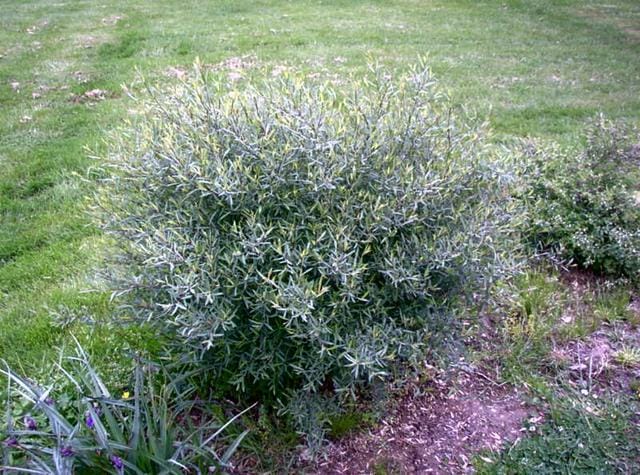
|
Added:
6/8/2010
Tree & Shrub
Artic Blue Willow
salix purpurea
(nana)
This shrub’s slender purple have dark green foliage, each leaf marked by a blue tint to its underside. Adaptable to any soil, the Arctic Willow thrives best in direct sunlight, though it can tolerate some shade. Most will top out at 5 feet in height, while others can grow to 8 feet and taller.
|
Might be a good replacement for the peonies
Wish List
|
|
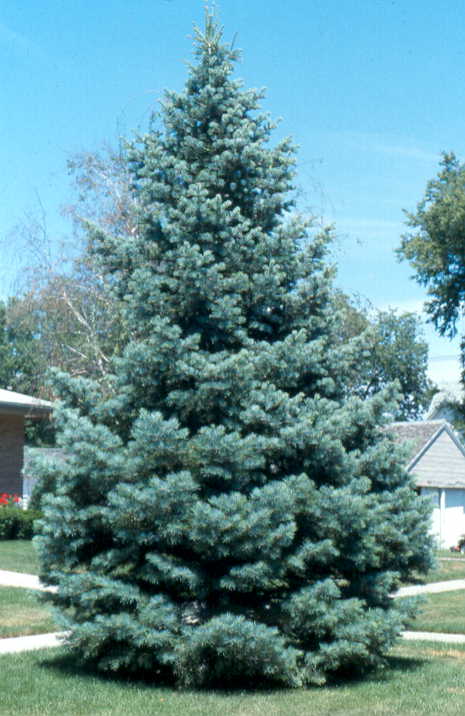
|
Added:
5/26/2010
Tree & Shrub
Concolor Fir
Abies concolor
Also called the white fir, it was designated the Great Plants® 2003 Tree of the Year by the Nebraska Statewide Arboretum. Its silvery-blue needles average two to three inches long and are surprisingly soft to the touch. The tree itself forms a strongly pyramidal silhouette with delicate texture.
It is native to the Rocky Mountains, southern Cascades and Sierras of the western United States. Those harsh environments means the concolor fir is well suited for Midwestern climates, possessing cold hardiness, moderate drought tolerance and a lack of pest problems.
In urban conditions, it will reach 50 feet tall and 30 feet wide. It grows at a slow to moderate rate and should be planted in full sun. An important requirement to remember is this fir will not be happy in a soggy, poorly drained site, so avoid heavy clay soils or areas intensely irrigated by lawn sprinklers.
|
Wish List
|
|
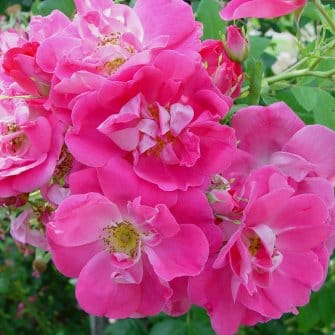
|
Added:
5/26/2010
Tree & Shrub
Rose, William Baffin
This is a hearty rose if we want a rose for light shade. Its not a tea rose.
|
Wish List
|
|
|
|
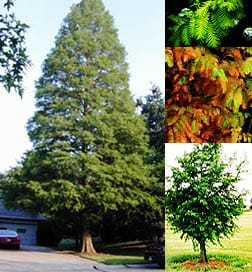
|
Added:
5/26/2010
Tree & Shrub
Dawn Redwood
Metasequoia glyptostroboides
The Dawn Redwood tree, Metasequoia glyptostroboides, is a deciduous conifer, with soft needle-like leaves that look like evergreens, but are bright green in the spring and brilliant orange/red in the fall. The needles are shed in the cold season of winter. Dawn Redwood trees are a very ornamental and interesting large tree, one of the few deciduous conifers in the world. It is feathery pyramidal in form with a straight, fluted trunk. It grows very fast to 40’ and can grow to 70’.
The bark is red- brown, fissured and exfoliating in long strips. It is a beautiful and stately tree, well suited for large areas. It makes a very effective, fast growing screen, perfect as a long driveway alley. This tree does best in full sun and when provided with adequate moisture. The Dawn Redwood has been called "a living fossil" because it was first discovered in Japan in 1941 and then found growing in the wild in China. The species is over 50 million years old. It is a very hardy tree and tolerates windy sites.
|
alternative -- Bald CypressTaxodium distichum
From the Nebraska State Arboretum -- we have learned that dawn redwood (Metasequoia glyptostroboides), Japanese maple (Acer palmatum) and flowering dogwood (Cornus florida) do poorly throughout the state.
General
|
|
|
|
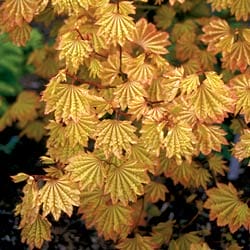
|
Added:
5/26/2010
Tree & Shrub
Vine Maple Sunglow
Acer circinatum Sunglow
A dwarf habit, intense color changes, and a terrific ability to withstand heat and humidity. Each leaf is an exquisite little fan, and with every season come new hues to delight you. The leaves unfurl in spring a bright yellow overlaid with coral. You can still see traces of this coral around the edges in summer, and then in autumn the foliage turns a brilliant, rich plum. The look of these leaves might remind you of the Japanese Full Moon Maple, but Sunglow is a far better tree for warm climates. It is quite tolerant of heat and humidity, and is a native tree (found along the Pacific Coast). Culture it as you would a Japanese Maple, however, giving it a break from full afternoon sun. Sunglow reaches just 5 or 6 feet tall after 10 years' growth, eventually topping out at 8 feet high and 6 feet wide. It is a multi-stemmed tree with a full, dense, shrubby look that is very attractive. Give it partial sunlight only, keep it very well-watered and fed the first few years, and it will reward you with a lifetime of beauty. Zones 5-8.
|
Nancy order on fall 2005
Wish List
|
|
|
|
|
|
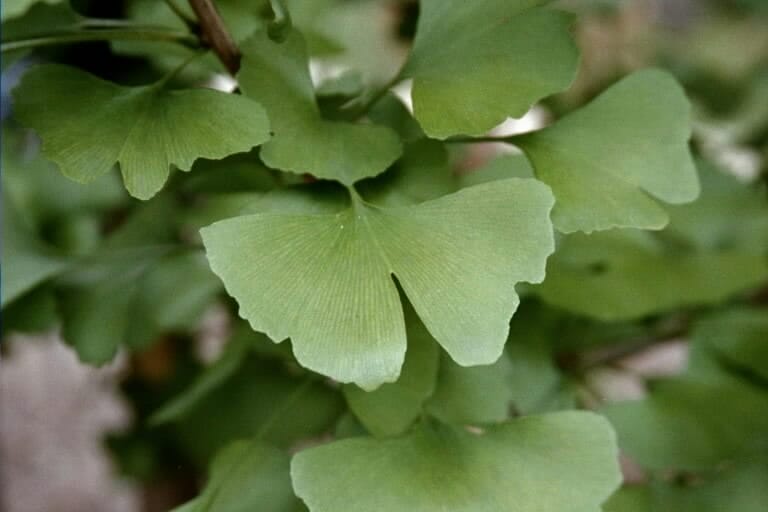
|
Added:
5/26/2010
Tree & Shrub
Ginkgo
Ginkgo biloba
Undoubtedly one of the most distinct and beautiful of all deciduous trees. The bright green, fan-shaped leaves are actually fern leaves, from the Age of the Reptiles. The leaves can turn a brilliant golden yellow in the fall. One of the oldest trees, growing on earth for over 150 million years and was native in North America at one time. Usually pyramidal in youth, in old age, a well-developed Ginkgo is an impressive sight, forming large picturesque branches and handsome bark. Female trees produce a malodorous fruit after 20 years, and for this reason, usually only male trees have been selected. A durable tree for difficult landscape situations! In western Nebraska the Ginkgo prefers a protected site with supplemental moisture to aid in establishment. We recommend the male selections 'Autumn Gold' and 'Princeton Sentry' for the landscape. 50-60' h, 30-40' w. Hardy to zone 4.
|
Orange Bed
|
|
|
|
|
|
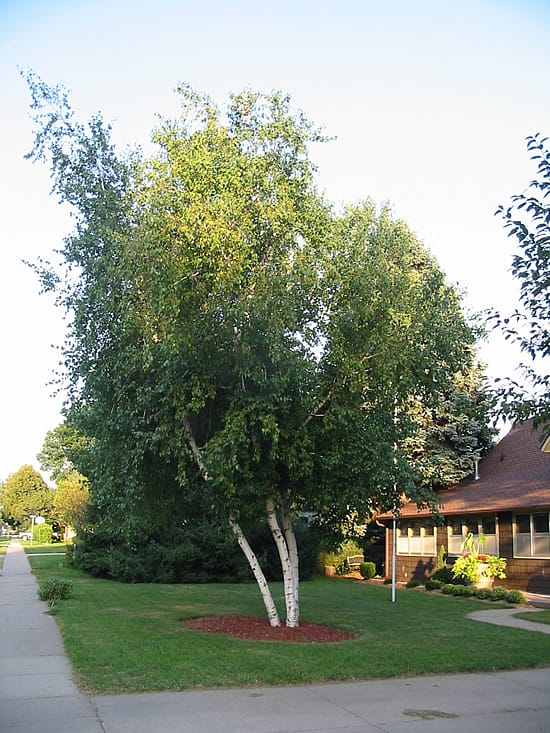
|
Added:
5/25/2010
Tree & Shrub
River Birch
Photo from 2005
|

June 2000
June 2000
General
|
|
|
|
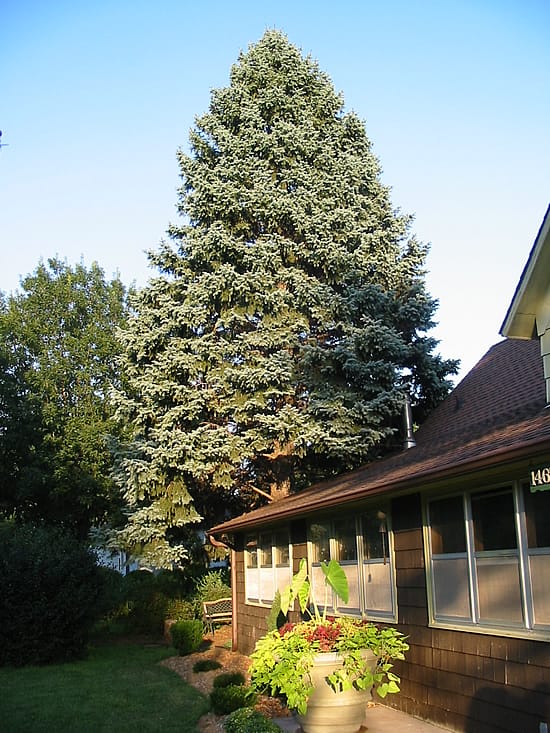
|
Added:
5/25/2010
Tree & Shrub
Colorado Blue Spruce, Large
|
July 2005
General
|
|
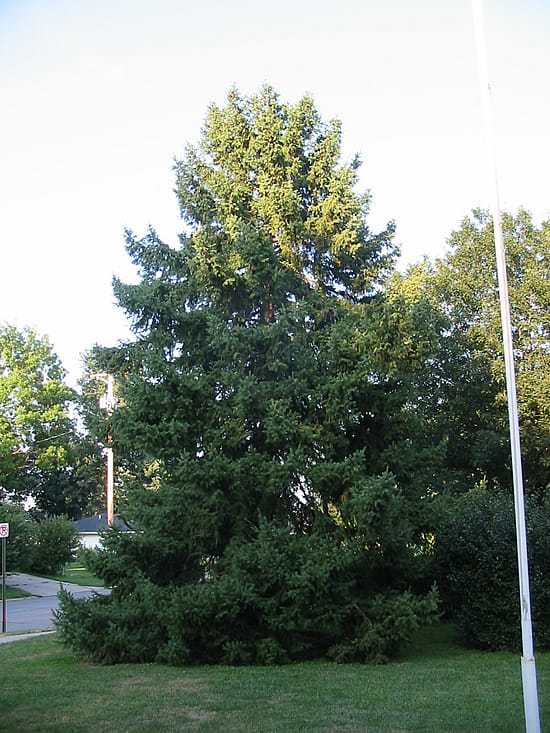
|
Added:
5/25/2010
Tree & Shrub
Green Spruce
|
July 2005
General
|
|

|
Added:
5/25/2010
Tree & Shrub
Russian Olive
Growing in any soil, the Russian olive is found in a variety of habitats. It is tolerant of alkaline soils, salt spray, cold, drought and pollution. It prefers cool, dry climates and light, sandy loams and requires full sun.
|
Wish List
|
|
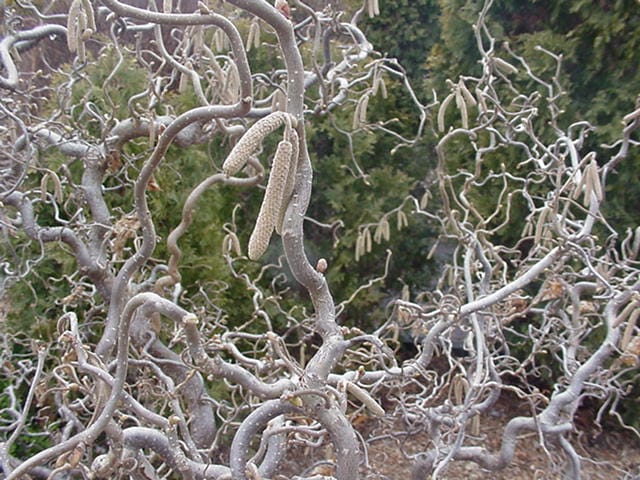
|
Added:
5/25/2010
Tree & Shrub
Harry Lauder's Walking Stick
Corylus avellana
(Corkscrew Filbert)
This shrub reaches a height of 8'-10', with a similar spread. The flowers are yellowish-brown "catkins," as on pussy willows. The blooms appear in early to middle spring. The shrub is grown primarily its unusual branching pattern, which is indicated by its other common names: corkscrew filbert and contorted hazelnut.
|

Wish List
|
|
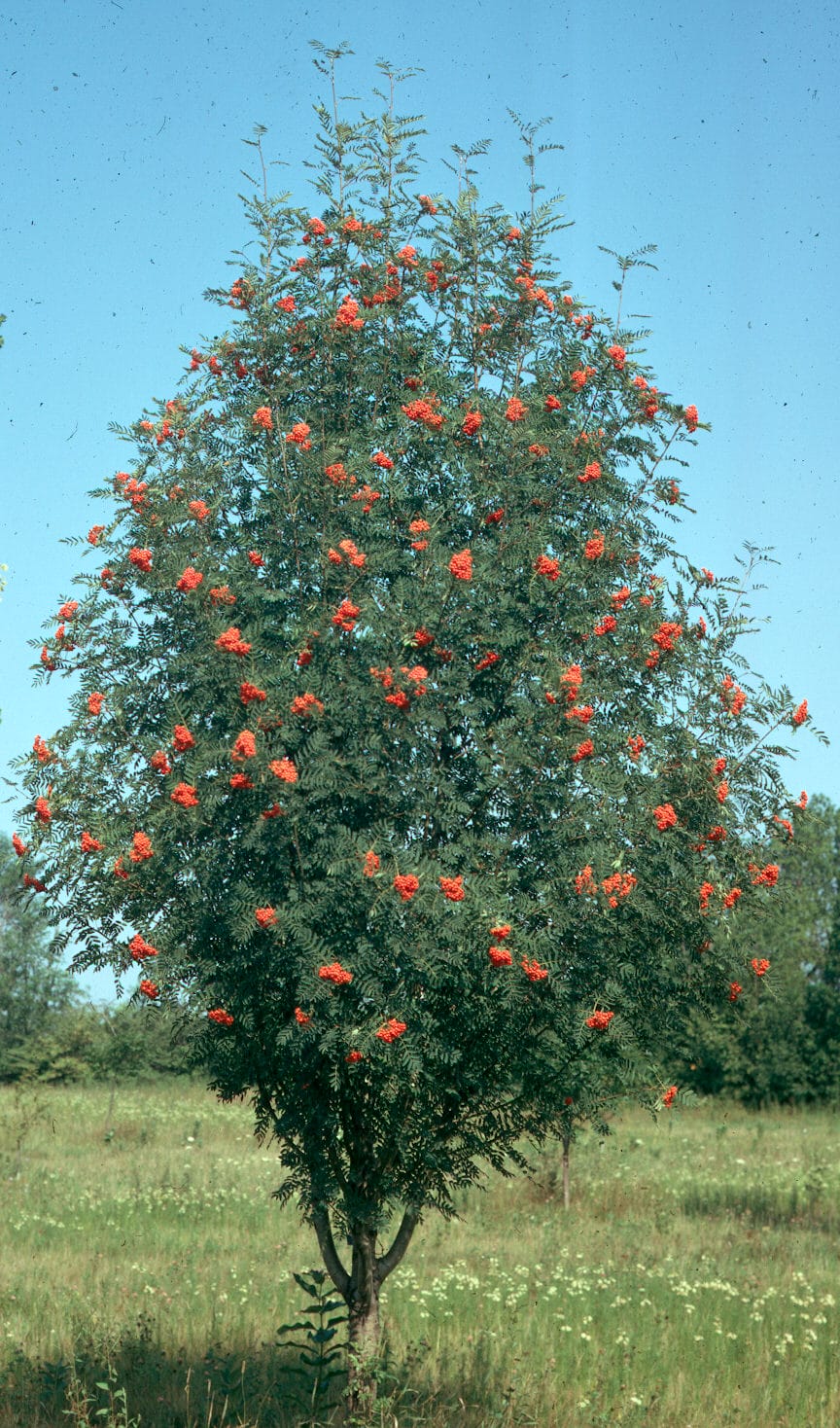
|
Added:
5/25/2010
Tree & Shrub
Mountain Ash
Sorbus aucuparia
The Mountain Ash is not related to the true Ashes, but has derived its name from the similarity of the leaves. In comparison to the true Ash, it is but a small tree, rarely more than 30 feet high. It belongs to the order Rosacece and is distinguished from its immediate relations the Pear, Crab Apple, White Beam and Wild Service Tree by its regularly pinnate, Ashlike leaves. It is generally distributed over the country in its wild state, but is also much cultivated as an ornamental tree.
The fruit is rather globose, with teeth at the apex and two to three seeded cells. The bark has a soft, spongy, yellowishgrey outer layer and an inner thicker portion, with many layers of a light brown colour. It has a bitterish taste, but is odourless.
|
 
General
|
|
|
|
|
|
|
|